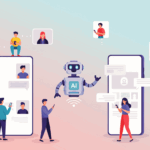AI Bias and Safety Are Really the Same Problem
Introduction
When we talk about AI challenges, we often discuss safety and bias as separate issues requiring different solutions. As AI systems become more powerful and widespread, however, it gets clearer that these aren’t two distinct problems. Instead, they’re different ways of looking at the same fundamental challenge.
Traditionally, AI experts consider safety and bias mitigation to be entirely separate issues.
- AI Safety focuses on preventing harmful AI behavior, while
- Bias mitigation addresses unfair treatment of different groups.
How does AI bias connect to cyber-safety and personal protection? Let’s dive in!
The Traditional View: Three Separate Problems
As AI systems moved from theoretical and high-tech spheres into real-world applications, the boundaries between safety and bias concerns have started to noticeably and significantly blur. AI Safety researchers have come to realize that bias isn’t just a fairness issue. It’s a core safety concern.
When an AI system makes biased decisions, it can cause real, systematic harm. A medical AI that works poorly for certain demographic groups isn’t just inaccurate, but it’s dangerous to proper healthcare for those individuals.
We might also consider facial recognition systems trained primarily on lighter-skinned faces. When these systems show higher error rates for people with darker skin, this represents both a bias problem and a technical failure. The system can’t cooperate with full spectrum of human faces it will encounter in the real world, which delays the integration of wider-spread use of this technology. Everyone sees less of it because of the inherent bias.
As another example, an AI assistant might generate helpful, appropriate responses for most users but produce biased or offensive content when prompted with (or without) certain cultural contexts. This also indicates problems with safety controls and fair treatment.
Safety in All Areas of AI
This shift in perspective has transformed how we think about safety. Modern AI safety testing often examines whether systems exhibit different error rates across demographic groups, and safety constraints are built directly into training processes to prevent discriminatory outputs.
This pattern repeats across domains. A language model that works well for standard English but struggles with dialects or non-native speakers could similarly not gain worldwide traction.
Ultimately, you can’t have truly safe AI without addressing bias, because biased AI is inherently unsafe for the groups it discriminates against.
The problems are connected. The solutions need to be too.
Conclusion
These issues don’t just coexist. They actively reinforce each other, creating dangerous feedback loops.
As AI systems become more powerful and widespread, the stakes of getting this wrong increase dramatically. Large language models can influence public opinion. AI hiring tools affect millions of job seekers. Medical AI systems make life-and-death decisions.
A system fed by changing human opinions may exhibit biased outcomes. Those biased outcomes represent safety failures. Safety measures that don’t account for diverse conditions may appear to work in controlled testing, but then fail catastrophically in deployment.
The future of AI isn’t just about making systems more powerful. It’s also about making them trustworthy. That requires recognizing that safety without fairness isn’t really safe, and addressing bias isn’t just about fairness—it’s about helping make sure that AI works for everyone.
The post AI Bias and Safety Are Really the Same Problem appeared first on Cybersafe.


